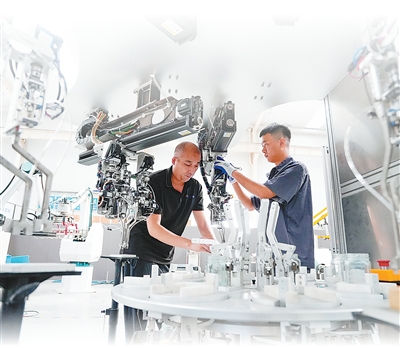




- BRNN
- BRI News
- BRNN News
- Database
Official Documents Polices and Regulations
Inter-government Documents International Cooperation BRI Countries
Business Guide Economic Data BRI Data
Trade
Investment Projects Latest projects
Cases - Content Pool
In north China's Hebei Province, shared manufacturing is enabling enterprises to pool resources, cut costs, improve efficiency and pursue coordinated development.
The 2025 government work report stated that China will advance trials for the integrated development of advanced manufacturing and modern services to accelerate the development of service-oriented manufacturing.
In September, the Ministry of Industry and Information Technology, along with six other departments, jointly released a plan to cultivate and promote shared manufacturing.

Workers check on irradiated photovoltaic cables in the shared irradiation workshop of Hebei Ouda New Energy Technology Co., Ltd. in north China's Hebei Province. (Photo/Sun Yawei)
Since 2024, Hebei Province has launched plans to promote the development of smart shared manufacturing across six areas: collective procurement of raw materials, key equipment, manufacturing processes, product design, technological innovation, and logistics and trade.
To date, 168 enterprises in 89 key industrial clusters across Hebei have set up shared factories, providing open access to production, research and development, and testing resources. More than 10,000 sets of equipment are shared, benefiting over 13,000 enterprises in improving their efficiency.
Baichuan Robotic Shared Intelligent Manufacturing Factory in Tangshan city, Hebei, provides a platform for enterprises of various sizes to achieve coordinated development.
Covering an area of 150,000 square meters and starting operations at the beginning of 2024, the factory boasts 800 sets of equipment and more than 1,000 production and R&D personnel. It can produce 3,000 sets of robotic products every year.
According to Wang Mengzhao, head of the factory, robot R&D and manufacturing require advanced equipment and modern workshops, an investment that can be prohibitively expensive for small- and medium-sized enterprises (SMEs). The shared factory allows them to pay only for what they use, significantly reducing their financial burden. In addition, the factory offers flexible production units customized to meet the diverse needs of different enterprises.
In 2019, Tangshan Siwei Intelligent Technology Co., Ltd. settled in the incubation center of a national Torch Program characteristic industry base in Tangshan, where the shared factory is located.
"As the company grew, our original production capacity could no longer meet rising demand. Upgrading required investment, and maintenance added to labor costs, making the overall expenses quite high," said Chen Yaoqi, general manager of the company.
"After moving into the shared factory, we've been able to use advanced equipment and cover part of the costs with government-issued vouchers, achieving higher efficiency at lower costs," Chen added.
"The shared factory helps SMEs housed in the incubation center improve efficiency by more than 10 percent and lower costs per product by more than 8 percent," said Wang.
Ningjin county in Xingtai city is the largest wire and cable production hub in north China. In recent years, with the ongoing growth of the new energy sector, local production of photovoltaic cables has expanded rapidly. One essential step in the production process is irradiation.

A technician measures the 3D dimensions of a bearing in the China-Serbia (International) Bearing Industry Shared Laboratory in north China's Hebei Province. (Photo/Shen Jianrong)
"An electron accelerator used for irradiation costs about 10 million yuan ($1.4 million), which is far beyond the reach of most SMEs," said Bo Naiqin, general manager of Hebei Huiming Cable Co., Ltd.
Bo said Ningjin is home to more than 2,000 wire and cable manufacturers and related companies, yet none of them owned an electron accelerator in the past.
"As a result, many companies either had to turn down related orders or transport their products elsewhere for processing," Bo recalled.
In July 2023, with support from the local government, two leading enterprises in the industry jointly invested in the county's first shared irradiation workshop, the Ouda Irradiation Center.
With a total investment of over 48 million yuan, the center is equipped with four electron accelerators that can irradiate about 1.6 million meters of photovoltaic cable per day at full capacity.
In 2024, the Ouda Irradiation Center processed nearly 160 million meters of photovoltaic cable, serving more than 80 local enterprises.
By sharing manufacturing capacity, the center has helped SMEs cut costs and boost efficiency. But that raises a question: why would large enterprises with premium production resources be willing to open their doors to smaller firms?
"For us, the challenge with high-end equipment and smart production lines is not that we can't use them, but that we can't keep them fully utilized," explained Zhao Heyi, general manager of Hebei Ouda New Energy Technology Co., Ltd., which operates the Ouda Irradiation Center.
"By sharing the workshop facilities, we can earn extra income and put idle production capacity to better use," said Zhao.
In the production workshop of Yijinlai Metal Wire Co., Ltd. in Ningjin, copper rod reels are fed into wire-drawing machines for production.

Photo shows an intelligent mechanical device jointly developed by Tangshan Siwei Intelligent Technology Co., Ltd. and Baichuan Robotic Shared Intelligent Manufacturing Factory. (Photo/Zhao Liang)
"Copper rods are purchased by the reel. Each reel weighs over 4 tonnes, and a truck typically carries about eight reels, costing more than 2 million yuan. We can't use that much material at once. But suppliers usually only ship when they can fill a truckload," said Cao Huizhao, head of the company.
Cao used to struggle with timing his orders. "Buying a batch of copper rods would tie up most of our working capital. But if we waited until we needed raw materials, prices might spike, and there was no guarantee we could get what we needed in time."
At the end of 2023, under government guidance and through coordinated enterprise efforts, Ningjin established an import and export company to centralize the bidding and procurement of copper rods and related materials.
According to Tao Haowei, the company's head, centralized purchasing and logistics have reduced procurement costs by approximately 100 yuan per tonne of copper rods. In 2024, the wire and cable industry in Ningjin lowered raw material costs by a total of 56 million yuan.
In the China-Serbia (International) Bearing Industry Shared Laboratory, technicians are using precision measuring instruments to test the diameter of a bearing produced by Xingtai Yuanyao Bearing Co., Ltd.
The laboratory, jointly established in June by Linzhou Group (Hebei) Bearing Co., Ltd. and a Serbian bearing company, is equipped with world-class testing facilities and professional technicians. It offers comprehensive services for enterprises in the cluster, including product testing and R&D, said the lab's director.
The shared lab has given Xingtai Yuanyao Bearing Co., Ltd. the confidence to innovate.
"Small enterprises like ours lack both funding and technical talent. Now, with a shared lab right on our doorstep, we can test products anytime, apply the results directly in production, and use them to improve our technology and processes," said Hao Hongxia, general manager of the company.
In recent years, Linxi county has leveraged its R&D platforms and leading enterprises to attract institutions such as Yanshan University. Together, they have formed specialized service teams that provide targeted R&D support to enterprises in the bearing industry, ensuring research efforts align closely with industry needs.
To date, with the support of shared R&D services, Linxi county's bearing industry has converted six scientific and technological achievements, overcome three key technical challenges, and obtained 23 patents.

Tel:86-10-65363107, 86-10-65368220, 86-10-65363106